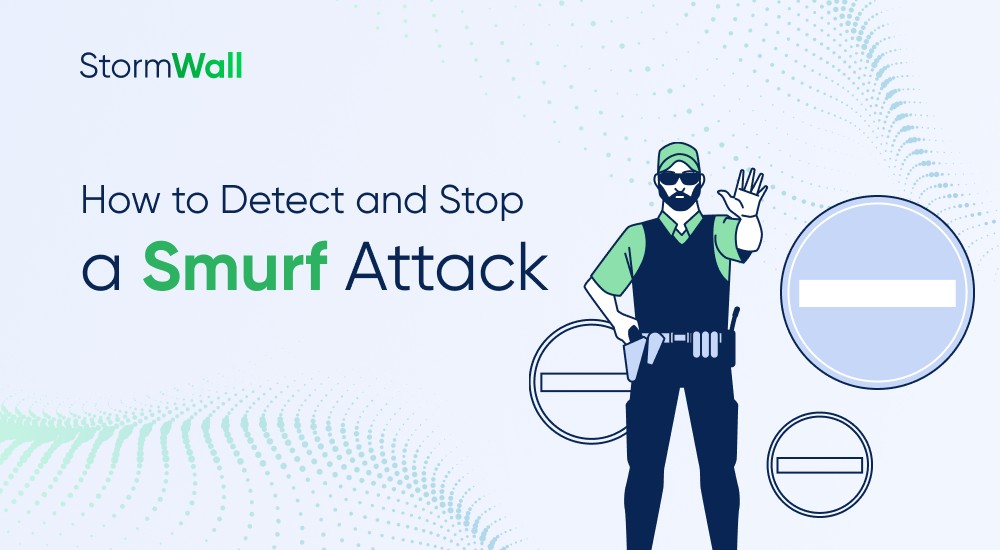In the world of DDoS attacks, some threats are often considered relics of the past. They’re outdated and no longer capable of causing serious harm. One such “veteran” is the smurf attack.
First gaining attention in the 1990s, the smurf attack may not rank high on today’s threat lists, but it can still be highly disruptive under the right conditions—and dangerous for businesses that aren’t properly protected.

What Is a Smurf Attack?
A smurf attack is a type of DDoS attack that abuses the ICMP (Internet Control Message Protocol). The attacker sends ICMP Echo Request packets (commonly known as “pings”) to a network’s broadcast address—but with a twist: the source IP address is spoofed to appear as the victim’s.
As a result, all devices on the target network respond to the victim, not the attacker. This causes a sudden flood of reply packets that can overwhelm the victim’s bandwidth and infrastructure, leading to slowdowns or complete service outages.
The term “Smurf attack” originated from a tool of the same name that cybercriminals used to carry out DDoS attacks back in the 1990s. Even a small ICMP packet generated by this tool could lead to catastrophic consequences for the victim.
The attack’s behavior resembled that of the Smurfs—tiny characters from the well-known cartoon series who could take on massive challenges despite their size. Smurf attacks follow the same logic: they require minimal effort to launch but can cause significant damage.
Back in the 1990s, when internet infrastructure was far more vulnerable, smurf attacks were a major concern. Today, thanks to improved network configurations, smarter routers, and dedicated DDoS protection services, they’re far less common.But don’t be fooled—while traditional smurf attacks may be rare, their underlying concept lives on. Smurfing is a classic example of an amplification attack—where the attacker uses third-party systems to magnify traffic. This technique is still used today in more advanced attacks, like NTP and DNS amplification.
How a Smurf Attack Works
A smurf attack exploits the ICMP protocol—specifically, ICMP Echo Request (ping). Here’s how it typically unfolds in practice:
- The attacker sends a spoofed ICMP Echo Request to a network’s broadcast IP address. In this request, the source IP is forged to appear as the victim’s IP address.
- All devices within that network that receive the broadcasted request respond to it, as they assume it is a legitimate ping request.
- These devices send their ICMP Echo Replies not to the attacker, but to the victim, whose IP address was spoofed.
- As a result, a single ping generates a large number of replies, overwhelming the victim’s bandwidth and network hardware. The surge in traffic renders the target system or service unavailable.
Types of Smurf Attacks:
- Standard Smurf Attacks occur when the target network becomes the origin point of the flood. The attacker uses a spoofed source IP set to the victim’s address and sends it to a network’s broadcast address. If that network responds, every connected device replies to the victim, potentially crashing the system through traffic overload.
- Advanced Smurf Attacks begin similarly but introduce a twist: the echo requests are configured to appear as though they originate from another, third-party victim. That victim then receives a barrage of replies from the targeted subnet, despite not initiating the request.
The success of smurf attacks largely depends on misconfigured or outdated network equipment. If your infrastructure allows ICMP broadcast requests and doesn’t restrict devices from replying to them, you are likely vulnerable. Proper network configuration is crucial to preventing such amplification-based DDoS attacks.
What Makes Smurf Attacks Challenging
Smurf attacks are considered relatively easy to execute. Unlike more complex DDoS techniques, they don’t require the attacker to operate a large botnet or access significant computing resources. All it takes is crafting the right ICMP request and targeting a vulnerable network.
Identifying the true source of a smurf attack can be difficult. In traffic monitoring systems, the origin of the attack often appears to be the IP addresses of the devices that responded to the spoofed broadcast—rather than the actual attacker.
Another challenge lies in the fact that the ICMP protocol is widely used for legitimate purposes (e.g., network diagnostics, latency checks). As a result, blocking all ICMP requests isn’t usually an option—doing so can disrupt essential services and diagnostics across a network.
How to Avoid Getting Caught in a Smurf Attack
It’s simple: you need to monitor your network traffic closely and have protective measures in place beforehand.
A sudden spike in ICMP traffic—especially when requests are sent to broadcast addresses—is often the first warning sign of a smurf attack. To prevent this, configure your routers and switches not to respond to such broadcast requests.
Additionally, you should restrict ICMP traffic using Access Control Lists (ACLs), blocking unnecessary echo requests. Enabling Unicast Reverse Path Forwarding (uRPF) can also help—it drops packets with spoofed source IP addresses before they enter your network.
If an attack is already underway, act quickly: block the source if possible, reconfigure network equipment to discard broadcast packets, and contact your service provider to filter malicious inbound traffic. A well-prepared infrastructure with proper monitoring and filtering drastically reduces the risk and impact of smurf attacks.
How to Protect Against Smurf Attacks
Despite being an older type of DDoS attack and sometimes challenging to detect, smurf attacks can be effectively mitigated with the right measures.
The key is to implement a few essential steps at the infrastructure level:
- Restrict the handling of broadcast ICMP requests and disable automatic replies to them.
- Enable traffic filtering for spoofed IP addresses and monitor ICMP activity within the network.
In addition, it’s strongly recommended to use anti-DDoS services for networks that can detect and block reflected ICMP traffic at the appropriate OSI layer. This is especially critical because even short-lived attacks can lead to service interruptions or the failure of vital systems.
In Summary
The smurf attack is a striking example of how outdated techniques can still cause real damage if basic security practices are neglected. It’s a compelling reason to keep your infrastructure configurations up to date and to implement professional DDoS protection. Remember: even the smallest “smurf” can become a monster—unless it’s stopped at the edge of your network.

Network Protection from DDoS Attacks
- Activate protection within 10 minutes
- 24/7 technical support




















